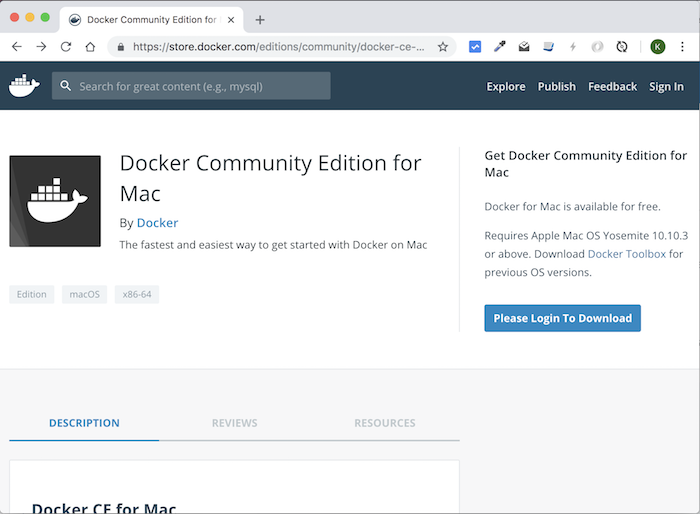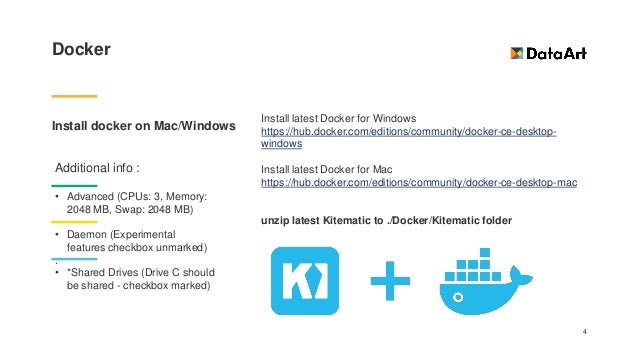
- #Docker ce for mac how to#
- #Docker ce for mac for mac#
- #Docker ce for mac install#
- #Docker ce for mac update#
- #Docker ce for mac mac#
Release notes lists component updates, new features, and improvements associated with Docker Desktop releases.FAQs provide answers to frequently asked questions.Troubleshooting describes common problems, workarounds, howto run and submit diagnostics, and submit issues.
#Docker ce for mac how to#
Getting started provides an overview of Docker Desktop on Mac, basic Docker command examples, how to get help or give feedback, and links to other topics about Docker Desktop on Mac.Refer to the back up and restore datasection to learn how to preserve important data before uninstalling. Uninstalling Docker Desktop destroys Docker containers, images, volumes, andother Docker related data local to the machine, and removes the files generatedby the application. Click Uninstall to confirm your selection.From the Docker menu, select Troubleshoot and then select Uninstall.To uninstall Docker Desktop from your Mac:
#Docker ce for mac update#
This installs the latest update and restarts Docker Desktop for the changes to take effect. All you need to do now is to click Update and restart from the Docker menu. When an update is available, Docker Desktop automatically downloads it to your machine and displays an icon to indicate the availability of a newer version. Starting with Docker Desktop 3.0.0, updates to Docker Desktop will be available automatically as delta updates from the previous version. If you would like to rerun the tutorial, go to the Docker Desktop menu and select Learn. Select About Docker to verify that you have the latest version.Ĭongratulations! You are now successfully running Docker Desktop. The tutorial includes a simple exercise to build an example Docker image, run it as a container, push and save the image to Docker Hub.Ĭlick the Docker menu () to see Preferences and other options. If you’ve just installed the app, Docker Desktop launches the onboarding tutorial. The Docker menu in the top status bar indicates that Docker Desktop is running, and accessible from a terminal. (In the example below, the Applications folder is in “grid” view mode.)
#Docker ce for mac install#
Install and run Docker Desktop on Macĭouble-click Docker.dmg to open the installer, then drag the Docker icon to the Applications folder.ĭouble-click Docker.app in the Applications folder to start Docker. The Docker Desktop installation includes Docker Engine, Docker CLI client, Docker Compose, Notary, Kubernetes, and Credential Helper. VirtualBox prior to version 4.3.30 must not be installed as it is not compatible with Docker Desktop. Docker Desktop currently supports macOS Mojave, macOS Catalina, and macOS Big Sur. As new major versions of macOS are made generally available, Docker stops supporting the oldest version and supports the newest version of macOS (in addition to the previous two releases). That is, the current release of macOS and the previous two releases.

If you experience any issues after upgrading your macOS to version 10.15, you must install the latest version of Docker Desktop to be compatible with this version of macOS.ĭocker supports Docker Desktop on the most recent versions of macOS. We recommend upgrading to the latest version of macOS.

#Docker ce for mac mac#
Your Mac must meet the following requirements to successfully install Docker Desktop:
#Docker ce for mac for mac#
Docker CE is available for all major platforms including MacOS, Windows and Linux.ĭocker Desktop for Mac is the Community version of Docker for Mac.You can download Docker Desktop for Mac from Docker Hub.īy downloading Docker Desktop, you agree to the terms of the Docker Software End User License Agreement and the Docker Data Processing Agreement. I have the same problem on my macOS 10.13.6 using Docker 18.06.1-ce: $ docker version Client: Version: 18.06.1-ce API version: 1.38 Go version: go1.10.3 Git commit.ĭocker is a platform for developers and sysadmins to develop, deploy, and run applications with containers. This is an update from the Mac-specific, available since version 17.06, and .internal, available since version 17.12, which may also still work on that platform. Works in Docker for Mac, Docker for Windows, and perhaps other platforms as well.

As of version 18.03, you can use as the host's IP. Release candidates): # $ curl -fsSL -o test-docker.sh # $ sh test-docker.sh # NOTE: Make sure to verify the contents of the script # you downloaded matches the. # This script is meant for quick & easy install via: # $ curl -fsSL -o get-docker.sh # $ sh get-docker.sh # For test builds (ie. Please use the link that's printed in the console after startup for simplified login. Docker-compose -f docker/docker-compose-jupyter.yml up This will create a docker-container running jupyter lab, which will be accessible using.


 0 kommentar(er)
0 kommentar(er)
